Media | Articles
The Porsche 356 paved the way for a sports car giant
More than one German industrial city was severely damaged by Allied bombs during the Second World War, Stuttgart among them. Porsche Engineering Headquarters were (and still are) located in Zuffenhausen in the north sector of the city. Those facilities suffered no damage, however, thanks to German Reich Minister Albert Speer. That said, Porsche Engineering personnel in 1944 relocated to Gmünd, Austria, a town close to the Porsche family retreat in Zell am See, Austria. Their postwar return to company headquarters in Zuffenhausen was delayed until very late in 1950, due to those facilities being used as a postwar Allied command location.
Professor Ferdinand Porsche was under house arrest in the Alsace region of France, having been detained by the French at the end of the war. The company was under the control of Ferdinand (Ferry) Porsche II, son of the founder, assisted by Karl Rabe and designer Erwin Komenda. With a small group of management and engineering personnel and approximately 175 technicians, they initiated a very basic production facility in a series of buildings in Gmünd that had been used as a sawmill. There, the birth of the now-iconic Porsche 356 occurred.
Those early cars were primitive, even by the standards of postwar European production. Although the professor had designed and coordinated the manufacture of the very successful prewar mid-engined Auto Union grand prix cars as well as the three Volkswagen Type 60-K-10 aerodynamic examples for the high-speed Berlin-to-Rome 1300-plus-kilometer endurance race, this effort in Gmünd was truly the launching of Porsche as a car company.

Porsche chose the Swiss Grand Prix in Bern, held on July 4, 1948, to unveil the first Porsche to the public. After testing 356-001, European journalists described the car as “very pleasant to drive, handling as we imagined a modern car should be.” One week later, 356-001 was also demonstrated at the Innsbruck races with great acceptance by the public.
A mid-engined car has limited space not only for storage, but passengers as well. Before the first 356 was completed, Ferry Porsche had begun to design a more practical, more marketable model: a 2+2 coupe officially referenced as 356/2. The engine was relocated to the rear, aft of the rear axle, to allow two—albeit small—rear seats. This car would become known as the 356 Gmünd Coupe. The aluminum bodies were shaped by workers hand-hammering them over wooden body bucks—a very time-consuming process. Over the next two years, Porsche would produce about 50 examples of the Gmünd cars, including eight cabriolets. Today, these Gmünd cars are the most collectible of any of the 356 Porsches.
Marketplace
Buy and sell classics with confidence

Porsche is now a world-renowned brand with great racing success, but in postwar Europe, it was just one of many small car manufacturers, competing for recognition and public acceptance with the likes of Lancia, MG, OSCA, and Simca.
Though not intended to be a racing car, the 356 in 1951 was entered in the most prestigious annual sports car race in the world: the 24 Hours of Le Mans. The car’s entry was intended to give Porsche additional recognition. Three cars were originally slated to be entered but due to various pre-race road accidents while testing, a lone entry made the Le Mans start on June 23, 1951. Starting is one thing at Le Mans. Finishing after 24 grueling hours is another. But this single Porsche entry not only finished, it also won its class. It managed a top speed of 100 mph and a best lap of 86.5 mph around the 8.5-mile circuit—not bad for a car with a 1086-cc engine producing 46 horsepower. This first (class) victory was the beginning of an unmatchable 20 overall Porsche wins at Le Mans to date.
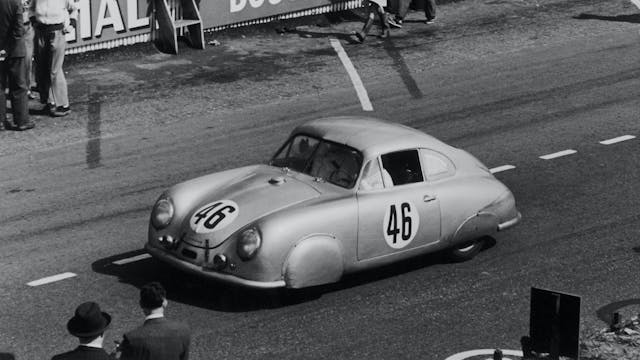
Back in Zuffenhausen, Porsche started to produce a 356 that had more roadability to appease would-be buyers. Produced in both coupe and cabriolet models, the cars initially had some carryover components from the Volkswagens of the period, but the new steel chassis had a box section running longitudinally along both sides of the floor section as well as through the center of the cockpit to provide additional structural rigidity; this benefited the cabriolet models in particular.
More important, the newer 356s would allow the company to show a profit for the first time since production began in 1948. Porsche’s original projections were for 150 cars to be produced in the first year at the Gmünd facility, but by the end of 1950, fewer than 60 total cars had been produced. Profit was nonexistent. As Ferry Porsche put it: “We did not go broke producing these cars in Austria, but this period did not produce any profit. It simply started at zero and remained at zero.”
The key element of being back in Germany was the ability for Porsche to align with a body manufacturer to construct the 356 bodies. A Stuttgart/Zuffenhausen-based company, Reutter, had produced the bodies for the three cars built for the prewar Berlin-to-Rome race. An initial order to Reutter for 500 bodies coupled with an agreement to lease 5000-plus square feet in the Reutter facility directly across the street from Porsche headquarters allowed production of the steel-bodied 356 to begin in early 1950, before Porsche gained access to their building.
The first Zuffenhausen Porsche was completed in the spring of 1950. Employees nicknamed the car “Greyhound.” Professor Porsche, now released by the French and back at his home in Stuttgart, gave it his blessing only after he had minor changes made to the body. Side-to-side symmetry differed by less than one inch, something that the professor was able to detect by eye.
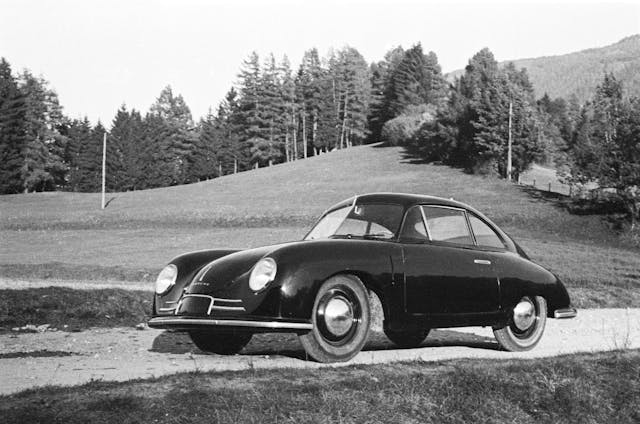
There were considerable differences between the German-produced cars and the cars built in the Austrian sawmill location. Gone were cable-operated brakes and lever-arm shocks, replaced by hydraulic brakes and telescoping shocks. The angular body shape of the Gmünd cars faded away to a smoother and more appealing appearance that would become known as the quintessential Porsche look. The spartan interior featured three gauges: a speedometer, an oil-temperature gauge (which was the lifeblood of the air-cooled four-cylinder engine), and a clock … which was wound by pulling a spring-loaded cord. Without a fuel gauge, the driver knew to measure the fuel in the tank located in the front trunk (along with the spare tire) by using the wooden stick also located in the front trunk. At a point when the engine started to starve for fuel, the driver could tap a small reserve of fuel by turning a lever located under the dash.
A two-piece windshield was used with radiused ends to allow a better field of vision for driver and passenger. The air-cooled engine was located aft of the rear axle as it had been in the Gmünd cars, still producing 46 horsepower. The front and rear bumpers were flush with the body of the car, producing a clean aerodynamic look.
A total of 298 Zuffenhausen Porsches were completed by December 31, 1950. This was more than double the anticipated production. Reutter had to increase the size of its facility to accommodate production requirements. Porsche’s first milestone, the 500th German-built 356, was celebrated on March 21, 1951. Just five months later, Porsche celebrated the 1000th 356 produced in the Zuffenhausen works.
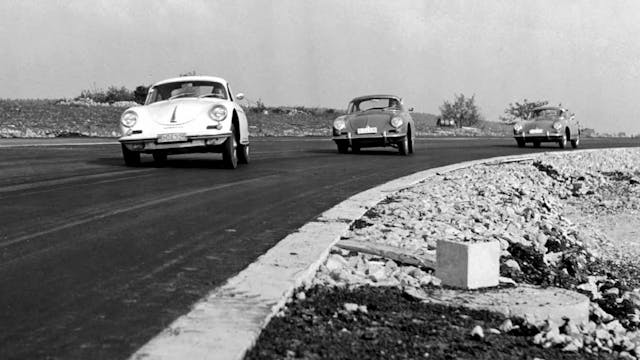
Enter car dealer Max Hoffman, whose facility on Park Avenue in New York City sold British and European sports cars. Hoffman had deep respect for Professor Porsche, and had imported three of the Gmünd cars. One went to the West Coast to dealer and racer John von Neumann. Hoffman sent the second car to Ed Trego in the Midwest. Fritz Koster, who lived on the East Coast, purchased the third car. Hoffman became the 356 conduit to the U.S.
Engine displacement was increased in 1951 to 1300 cc and later that same year to 1500 cc, boosting the output to 60 horsepower. Customers who purchased the cars marveled at the minimal amount of effort required to drive them at high speeds. Porsche had a winner, but the price of the car was considerable. The coupe was $4284 and the cabriolet was $4560. This was $300 more than the well-known—and more powerful—six-cylinder Jaguar 140 model.
Interior improvements included a very basic radio. Sun visors were added as well. A modified 1500-cc engine was offered in 1952, referred to as a 1500S (Super). Road wheels were widened from 3.25 inches to 4.5 inches. Bumpers were extended away from the body of the car with added overriders. Changes continued with improvements occurring monthly. Engines were available for customers in 1100-, 1300-, and 1500-cc displacements with both a 1300 and 1500 Super available. The Super offered additional horsepower.
Hoffman clearly saw the 356 as a great addition to his store. In a meeting with Ferry Porsche, he suggested that Porsche replace the individual letters with a crest. The Porsche crest, still being used to this day, was first developed in that meeting on a napkin. The logo blends the horse, which symbolizes Stuttgart’s origins, and the coat of arms from the state of Württemberg, of which Stuttgart was the capital.
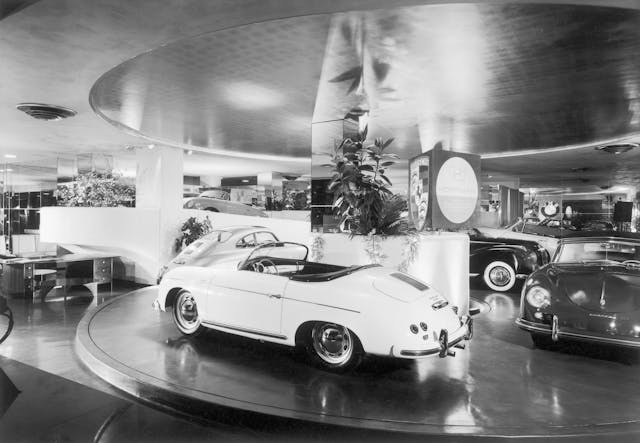
Hoffman also had another thought to assist in boosting Porsche’s U.S. (and his) sales. A small run of 16 cars with all-aluminum bodies was produced by Heuer-Glazer from 1952 to 1953 and named the America Roadster. These cars created a stir on U.S. racetracks with their success, but 16 cars were not what Hoffman had in mind. “Let’s get the price of a Porsche under three thousand dollars,” was Hoffman’s cry to Stuttgart. “Make it an open car. No more roll-up windows; replace them with side curtains. Get rid of the sun visors and the radio. Offer the car with a 1500-cc normal engine. Have only a speedometer, an oil pressure gauge, and a tachometer. Install lightweight bucket seats to convey the sporty look.” Lo and behold, Porsche produced the Speedster such that Hoffman could offer it at $2995. A 1500-cc Super engine was available for an additional $500. The cars tipped the scales at a little less than 1800 pounds and were able to reach a top speed of more than 100 mph. And the rest, as they say, is history … Porsche history.
Only minor body changes had been made since the beginning of production in 1950 at Reutter. A one-piece windshield had replaced the two-piece version. Larger taillights were utilized, as well as headlight changes. There were many alterations and refinements to the engine. Major suspension changes were made to provide a smoother ride as well as improving the handling of the 356. Body enhancements included a radiused windshield and rubber molding along the midpoint of both sides of the car. Wider tires were used on the 15-inch-diameter rims. Interior upgrades included a flat dash that featured a smaller radio and a glove box. The level of the floor pan was lowered by 1.4 inches, which made ingress and egress much easier. All these changes resulted in what Porsche would term the 356A model. On March 16, 1956, Porsche’s 356 total production reached 10,000.
During the years 1956 to 1959, Porsche offered customers the option of replacing the four-cylinder pushrod engine with the racing Carrera engine, which in a detuned form produced 100-plus horsepower. These engines were produced in 1500- and 1600-cc capacity. These 356 Carreras, as they became known, were frequently used at many race venues throughout six continents with great success.
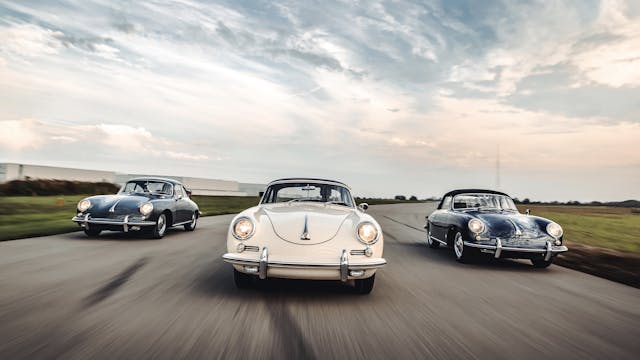
By 1959, Porsche was working on a new model that featured a rear-camber compensating spring and an engine that was now producing 90 horsepower from the 1600-cc pushrod powerplant. The nose of the body was very different, with a much larger bumper and larger overriders. The headlights were relocated higher in the front fenders and the top of the fenders were straightened. Horn grilles and driving lights appeared, as did additional grilles allowing greater airflow to assist in cooling the new, larger front brakes. Porsche referred to this model as the 356B series. The internal reference for the body was T-5.
A small run of 263 roadsters of the 356B model was produced for Porsche by the Belgian coachbuilder D’Ieteren Freres in 1961. The T-5 body was only in production for a short time. In late 1961, a body with the front trunk lid featuring a much straighter lower edge and rounded at the corners, referred to as a T-6, was its replacement. A more form-fitting fuel tank was designed with the filler neck now on the outside of the car, contoured to blend into the fender. A proper dash-mounted clock was installed. The rear window was enlarged, and the engine lid featured two air grilles rather than one.
The Carrera version continued to be offered in the 356B in both the coupe and the open cars. Front disc brakes used on the late Porsche Spyder race cars—a modified version of the drum brake referred to as the annular disc—were a new feature on the Carreras. Porsche had no purpose-built GT race cars during 356B production so 20 356B chassis were sent to coachbuilder Abarth located in Turin, Italy, to have aluminum aero-shaped bodies built and installed. This very collectible 356B was often referred to as the Italian Porsche, more properly referenced as an Abarth Carrera.
By mid-1963, Porsche was making additional changes to its ever evolving 356. Proper disc brakes with rotors and external calipers were fitted both front and rear. Cockpit improvements included repositioning of the light switch, changing the heater control, and deeper seats that increased headroom. Door arm rests were also added. The body remained unchanged, but the model was now referred to as the 356C for the final two years of the 356. Engines were still offered in 1600-cc displacement in both the coupe and cabriolet cars, with a 90-hp model referred to as the SC. A 2.0-liter variant of the four-cam engine was also available. This model was known as the Carrera 2. The last 356 was produced in September 1965; the 356 gave way to the 911 model with the new six-cylinder engine.
Over the 17 years of production, more than 75,000 cars were built—a far cry from the 50-plus cars built in that converted saw-mill in Austria. When driving your 356 and another 356 is coming in the opposite direction, make sure you flash your lights. This is a tradition that started 75-plus years ago, and it still exists today.
Porsche 356 is one of 20 classes to be featured at the 2023 Greenwich Concours d’Elegance, on June 2–4, 2023. Download the 2023 Greenwich Concours d’Elegance event program to learn more about Sunday’s other featured classes, Saturday’s Concours de Sport, our judges, sponsors, non-profit partners, 2022 winners and more!
***
Check out the Hagerty Media homepage so you don’t miss a single story, or better yet, bookmark it. To get our best stories delivered right to your inbox, subscribe to our newsletters.
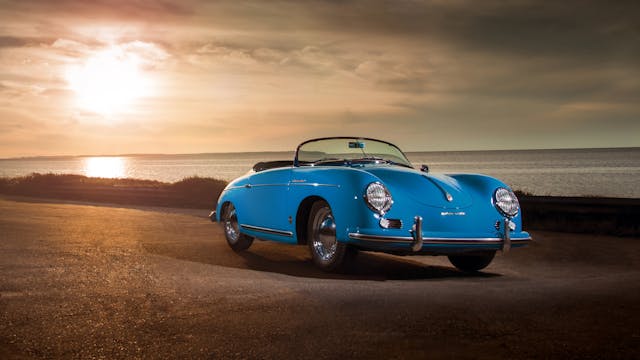

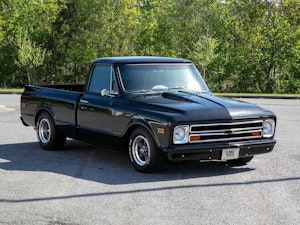


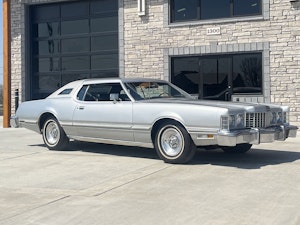












The key for Porsche was they learned to adapt to other markets early on. They were reliable, fun to drive and they evolved the cars as needed when they came to America they needed roll up windows and such.
The 911 also came at a time the 356 needed to be replaced. Both cars delivered a 1-2 punch in a market where small sports cars have generally short lives.
Only the Corvette and now the Miata has shown similar staying power.
Max Hoffman is certainly one of those underappreciated people who had a huge influence on the Porsche introduction to the USA – and subsequent successes through his input regarding changes and enhancements. I lusted after a Speedster back when I could have had one for around $10 grand (an amount that I just couldn’t lay hands on at the time). If I had ten times that amount right now, I couldn’t even touch the same car!